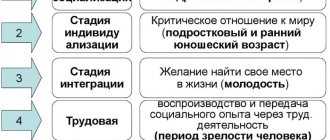Updated July 22, 2022 447 Author: Dmitry Petrov
Hello, dear readers of the KtoNaNovenkogo.ru blog. It is difficult to imagine a person’s day without at least some type of communication.
After all, this is not only necessary to resolve issues and achieve goals, but also to satisfy the needs of man as a rational being.
But what is communication: a simple exchange of words, or a more complex aspect in our lives? Is conversational skill a talent that some people have, or can it be developed? How important is it to talk to people, or can you do without it? Let's figure it out.
What is communication?
Communication is the interaction of people during which information, ideas and emotions are exchanged. It can occur both between individuals and between groups of people. Communication is a complex concept that includes such aspects as:
- exchange of information of all types (knowledge, experience, ideas, recommendations, etc.);
- mutual influence (impact on the state, manipulation, coercion to certain actions);
- interpersonal interaction and relationship formation;
- emotional rapprochement, mutual understanding, sharing of emotions;
- formation and use of certain behavior patterns;
- formation of the inner “I” and understanding of other people.
From the point of view of psychology, communication is the interaction between people, consisting in the exchange of cognitive or emotional-evaluative information. It is a manifestation of interpersonal relationships or leads to their formation and development. Any communication implies the presence of content (information transmitted) and purpose (the reason why the parties interact).
Communication means
Means of communication are methods of presenting, processing, transmitting, encoding and decoding information. Coding here means converting information into a form suitable for transmission (oral speech, paper letter, electronic message). Accordingly, decoding is the perception of what is said by ear, reading from paper or from the screen.
There are a large number of encoding methods and channels for transmitting information. Communication is possible only when both parties have a suitable coding method and are able to use the transmission channel. All existing means of communication are usually divided into two categories: verbal and non-verbal.
Verbal means of communication
This category includes all methods of communication that involve the use of speech (oral, written or otherwise).
Examples of verbal communication of information:
- spoken phrase;
- handwritten or typed text;
- electronic text message;
- inscription made in Braille;
- message encoded in Morse code;
- message transmitted using flag alphabet.
What all these methods have in common is that they involve the transmission of words consisting of letters encoded in a certain way. Thus, verbal means of communication are determined not by the channel for transmitting information, but by the way it is presented.
Nonverbal communication
Nonverbal means of communication include methods of transmitting information that do not involve speech coding. They may or may not depend on the will of the sender. For example, a person can wink, consciously putting additional meaning into his words. And a trembling voice can reveal the speaker’s excitement against his will.
Examples of non-verbal communication of information:
- features of handwriting, highlighting of words;
- facial expressions, gestures, posture (kinesthetic means);
- approaching or moving away;
- intonation and speed of speech, voice characteristics, pauses;
- symbols, signs and pictograms.
A characteristic feature of nonverbal methods of transmitting information is their relative independence from the language of communication. Although they cannot be called cultural universals, most people understand them correctly.
Why does a person need communication?
It doesn’t matter whether you are a sociable person or a withdrawn introvert who is used to being alone, everyone needs communication. The social need to talk with others like oneself is a natural need, and without its satisfaction it is impossible to feel complete.
Communication plays a vital role in human life. The difference may lie only in its quantity and frequency. So, for someone it will be enough to go somewhere with friends once or twice a week and talk with them in order to cheer up and improve their well-being, and for the rest of the days such a person may well be alone. But for some, communication plays a more important role - such a person cannot spend even 20 minutes alone with himself, begins to suffer from boredom and experiences an irresistible desire to contact someone. By the way, such a desire is more aimed at the process itself, and not at its final result.
Communication goals
The goals of communication are a set of reasons that force people to initiate the process of information exchange and participate in it. All possible goals of communication can be divided into two groups: functional (solving a specific problem) and objective (related to the search and choice of a partner).
Main functional goals of communication:
- exchange of information beneficial to both parties or one of them;
- getting help;
- helping another person;
- receiving an emotional response (praise, sympathy, solidarity, empathy);
- coordination of interaction (in work, play or other joint activities);
- joining a team or social group by accepting ideas, values, principles, moral standards and other attitudes;
- influence on the views and behavior of the interlocutor;
- self-expression, manifestation of one’s skills and abilities;
- enjoying the process of communication itself.
Objective goals of communication are goals related to finding and choosing a partner. Depending on what kind of partnership we are talking about (permanent or situational, personal or work), different factors are important (age, gender, education, sympathy, proximity to residence). Understanding these factors and understanding whether such a partnership is appropriate is the objective.
Stages of communication
The entire communication process can be divided into 5 stages:
- Awareness of need. It all starts with the need for a person to convey information to another.
- Analysis of circumstances and initiation of communication. At this stage, the most suitable channel and method of encoding information is selected (phone call, personal meeting, chat).
- Direct communication (message transmission). The sender formulates his thought and transmits it to the recipient in the chosen way.
- Receiving and analyzing feedback. The sender reads the recipient's reaction (response message) and interprets it.
- Correction of communication methods. The sender changes the style of communication and wording, adapting to the interlocutor in order to continue communication in the desired direction.
Communication functions
There are different approaches to classifying communication functions. In modern psychology, the approach of the Soviet psychologist Vladimir Panferov is considered one of the most accurate. He identified 6 functions:
- Communicative. Interaction between people at different levels (interpersonal, group, public).
- Cognitive. Communication is the main source of knowledge, gaining experience, and developing cognitive abilities.
- Informative. This function consists of transmitting information of varying degrees of importance.
- Creative. In the process of communication, social connections between people are formed, changed and developed.
- Conative. People have social roles that somehow relate to each other (for example, boss and subordinate). The conative function consists of the interaction of these roles.
- Emotive. This function ensures the exchange of emotions.
How did it all begin?
Have you ever thought about why a person needs communication? Try to imagine that during evolution the speech apparatus would not have begun to develop, and people themselves would not have shown any desire to somehow contact each other. What do you think, if a person had no desire to communicate and obtain new information, and therefore all the functions of communication would have been absent, there would have been evolution in the form in which we see it now and have seen it since humanity became interested in development all living things? Would we even have the slightest idea of what evolution is? The answer is clear: none of this would have happened. Communication played a role; in fact, it is the basis for the survival of all complex species, which is developed in many living organisms. And even if they present it not in the form to which we are accustomed, nevertheless...
Communication is the key to the development of civilization, the indestructible foundation of society. However, it is worth understanding that this does not only mean the sounds that we are able to reproduce with our speech apparatus. Deaf and mute people also “talk” to each other, although they use gestures rather than words to do this.
Communication in any of its forms is the exchange of information, the only possible option for transferring new knowledge, skills, experience to other people, because this is the only way to help each other, to help the human species survive and develop further, but this is not the only function of communication.
Types of communication
Depending on how the interlocutors perceive each other, several characteristic types of interpersonal communication can be distinguished:
- Primitive. One person perceives another as an object from which a certain benefit can be obtained (consumer attitude).
- Formal role-playing. The relationships between people are determined by their social roles, and communication is built taking this into account (for example, communication between a buyer and a seller or consultant).
- "Contact of masks." Superficial communication, during which people act out their social roles, depicting feigned emotions.
- Business. This is communication aimed at achieving a specific goal, during which the parties focus on business and ignore personal factors.
- Manipulative. A person resorts to various implicit techniques that allow him to achieve a certain reaction from his interlocutor and influence his opinion.
- Secular. This is communication on general and neutral topics. It is usually used by event participants who are unfamiliar with each other to make new connections.
- Spiritual. This is communication between close people, implying an exchange of experiences, emotional rapprochement.
Question 3. Communicative information side of communication. Communication process model
The information side of communication, i.e.
law enforcement officers attach particular importance to the transmission and receipt of information, as evidenced by the fact that 2/3 of the surveyed practical workers, as well as cadets and students of the Moscow University of the Ministry of Internal Affairs of Russia, when asked what they understand by communication, noted the importance of information exchange . The importance of operational information cannot be overestimated. Information exchange is relevant for the investigator, and for the detective, and for an employee of any police unit who, in the course of their official activities, establish the causes and circumstances of offenses, the motives for criminal activity, solve practical, educational problems and many others.
In the process of activity, people exchange various perceptions, interests, ideas, emotions, etc. Moreover, everyone strives to be correctly understood, wanting to receive from a partner a certain confirmation, a response to the information transmitted to him. The process of transferring information from one partner to another (or others) is not one-sided; it is always a relationship between people communicating, where the element of “feedback” plays a very important role.
In the “Who” scheme - the communicator, i.e. the person sending information; “What” is the content, the information itself; “To” - communication partner who receives information; “Effect” shows the effectiveness of communication, as understood by the communicator, and signals him about feedback. However, in order for this scheme to “work”, it is necessary for partners to use common communication tools: a system of signs, understanding situations, etc.
In essence, Code + Contact are tools of communication, means of transmitting information. The code consists of signs (symbols) and languages. There are different signs - genetic, chemical, thermal, road, etc. Human signs are of an extremely abstract nature and are conventional in nature. The system of signs is organized into languages: verbal language (sound, verbal), facial language, intonation, topomimic (gestures), written, etc. For effective communication, several sign systems are often used in parallel; in this way, reliable information transmission is achieved. Unconvincing acting on stage indicates improper use, for example, of verbal and facial language.
Learning signs (and languages) occurs in the first years of human life. There are phenomenal cases of proficiency in 12 languages. The wider a person's vocabulary, the greater his thinking and conceptual abilities. Context is the meaning field of a word. In different texts (and in different intonations), the same word can change its meaning. Depending on the social sphere and psychological characteristics of a person, differences are noted in the level and forms of his communication, the completeness and depth of mutual understanding with other people. In any given communication situation, we always learn something from our partner and communicate something to him. The content of a specific communication can be very different: an order from a boss, a call to wash your hands before eating, an interrogation of the accused, a conversation with witnesses, victims, etc. Whatever it is, it is always communication, and it is impossible to imagine communication without it.
Sides of communication
Psychologists consider communication a complex system that includes three subsystems (sides of communication):
- The communicative side of communication. This subsystem combines processes aimed at exchanging knowledge, opinions and ideas using both verbal and non-verbal means.
- Perceptual side of communication. This is people’s perception of each other, the formation of an opinion about a person in the process of interaction and communication.
- The interactive side of communication. These are all kinds of interactions that arise during joint activities of people (actions performed together, or actions of one person influencing another).
Styles and classification
Based on some features, communication in a person’s life can be divided into direct (immediate) and indirect (mediated). In the first case, communication between the interlocutors occurs directly; they communicate with each other using appropriate facial expressions, gestures, intonation and tone.
In the second case, information between interlocutors is not transmitted directly, but indirectly (letters, documentation, media, etc.). It is worth noting that direct communication has better effectiveness and impact on the interlocutor than indirect communication. However, the first type can be more subject to emotions, since such communication in the life of every person occurs in real time, and the second - to common sense, since there is time to comprehend the situation and analyze it.
There are also formal and informal types of communication, from which it follows that relationships between people are business and personal. Consequently, the rules of communication for each of the two types will be different. In the first case, sympathy or antipathy is expressed towards each other, respect or lack thereof, trust or distrust. But business communication is the relationship that develops between people who are members of certain social groups and organizations. It is based on the rights and obligations existing in a particular group (organization). Consequently, the role of communication in a person’s professional activity and its role in everyday life are significantly different. If in the first case a person is limited by certain frameworks and rules dictated by the organization (company), then in the second he is limited only by his own opinion, desires and character traits. What may be common here is perhaps the role of education, but not the role of communication in general.
The role of communication in human life
A person’s personality is formed in the process of socialization, and the basis of this process is communication. Therefore, it can be said without exaggeration that communication is the most important factor in personality formation. In addition, all spheres of society are built on communication, and every person constantly communicates with other people in his daily life.
Communication allows us to adapt, find a place in society, improve our position and receive various benefits. This means that the quality of our life directly depends on our ability to communicate. Every person has minimal communication skills naturally, but they need to be improved to achieve success. Therefore, communication should be treated not just as a form of interaction with others, but also as an important skill that needs to be developed.
Personality formation
At the stage of a person’s development as an individual, that is, from school years, communication with parents plays a particularly important role. Ideally, you should try to talk with them as much and as often as possible, share news and current events. It is extremely important when talking with parents not to deceive them, to be frank, sincere and honest. These are the goals of communication and their basic rules at this stage.
What seems incomprehensible to schoolchildren, for example, a parental ban, in most cases turns out to be the right decision. Just imagine if in our teenage years we were allowed absolutely everything. Probably, troubles would have followed us at every step, and we, being still children, would have had no idea how to get out of them.
The period of adolescence is especially important in the development of a person and his communication skills, in parallel with which the psyche develops. A person learns the essence of communication while he is growing up, studying at school, university. During this time, life’s baggage is replenished not only with scientific knowledge, but also with ordinary life skills, experience, both other people’s and one’s own. At this stage, for the most part, you have to be in contact with peers, but this incredibly helps the formation of personality. True, if only you adhere to the basic rules of human communication.










